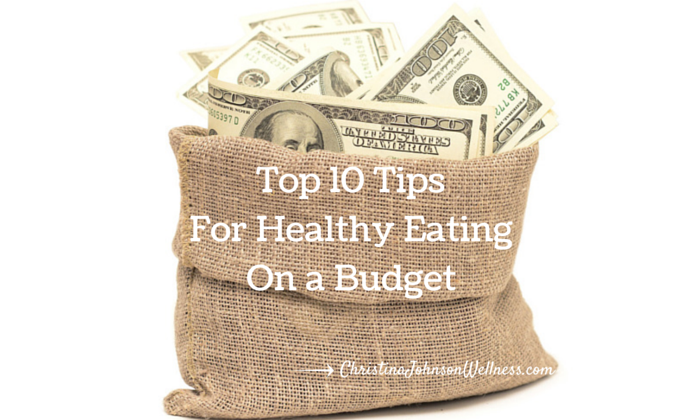Do you think it’s too expensive to eat healthy? For many people, the expense of buying healthy foods can be a huge roadblock to changing their eating habits. There is no denying that buying good quality, whole foods can be expensive, but there are many tips you can follow to minimize the damage done to your wallet. Here are the top 10 tips for eating healthy on a budget that I personally follow the most often.
1. Make it a Priority
My first tip is to make eating healthy a priority. Since you are on this website, I assume that you have either already done this, or are in the process of it. Yes, eating nutritious, whole foods can be expensive, but this is your health and your future that we are talking about!
2. Cut It Out
Think about it…how much money do you spend each month on your car payment? Cell phone bill? Cable? Clothes? We all have our priorities. If you want to eat healthy, then it’s time to decide what your priorities are.
For me, nothing else will matter if I am sick, unhealthy, and can’t enjoy life. So eating good food has become a priority. My husband and I have decided to stick with very basic cable and cell phone packages. We don’t eat out very often or drive through Starbucks every morning. And we drive cars that are 10 plus years old.
So how about you? If healthy eating is a priority for you, how can you shift your budget around? Here are some ideas to get you started…
- Beverages: Can you cut out beverages like soda, juice, bottled water, or coffee from coffee shops?
- Take a look at your bills: Can you reduce the amount of money spent on your cable bill or phone bill? Do you have any subscriptions or recurring costs that you could cancel?
- Eating out: Can you bring a lunch to work instead of going out? Maybe limit the number of times that you eat out per week?
- Entertainment: Can you have a family movie night at home instead of going to the movies? Are there free activities and events going on in your area?
- Car: Can you drive your car once it’s paid off for a couple more years before buying a new one? What about buying a used car instead of brand new?
Once you start looking at how you’re spending your money each month, you might be surprised at how much money you can cut out of your monthly expenses.
3. Meal Planning
One of the key ways that I save money is to plan all of my meals out in advance. Each week, I make a menu for meals and snacks, along with a corresponding shopping list. This prevents me from buying extra food that will go to waste. Here are some budget-friendly meal planning tips:
- Choose simple recipes: Avoid recipes with long lists of ingredients or with exotic ingredients that you may never use again. Plan suppers that consist of a meat, vegetable, and starch, and you’re good to go!
- Look at the grocery ads before you make your menu: Many stores have their ads online, or if you connect on Facebook or by email with your favorite stores, they may alert you to special deals.
- Be flexible: Oftentimes, for supper, my menu will simply say “veggie”. When I’m at the store, I will look for whatever vegetables are on sale. Or if ground pork is on sale, but I wanted ground beef, I substitute it out.
4. Cook from Scratch
When you cook from scratch, you can save money by not having to buy prepared foods. This is especially true of snacks. Think about how expensive processed snacks can be such as small packages of kale chips, gluten free crackers, beef jerky, Larabars, etc. You can make homemade versions of many of these items fairly simply at home, for less money, and with no questionable ingredients added!
5. Be Smart About Meat
Meat can quickly become the most expensive items on your grocery list. In order to cut this back some, try…
- Slightly reducing the amount of meat you use: Cut back slightly on the meat in a recipe and replace it with fiber rich (and filling) vegetables.
- Choosing inexpensive cuts of meat: Such as brisket, chuck roast, or ground meat
- Buying conventionally raised meat: While pasture-raised, organic meat is definitely preferable, this is not always a feasible option for everyone. If necessary, buy conventionally raised meat, but try to stick to lean meats when doing so. The problem with most conventional meats lies in the antibiotics, hormones, and chemicals these animals consume. Where do all of these toxins end up? Just as in humans, animals store these toxins in their fat. Therefore, if you are eating conventionally raised animals, simply choose the lean meats or trim excess fat to avoid overexposure to toxins.
- Find a local farmer who sells meat in bulk: Often, by purchasing a quarter or a half of a cow at a time, you can save money, while also getting the more expensive cuts of meat along with the inexpensive ones. We have purchased pork, beef, and lamb this way by setting aside money from our grocery budget every month to use towards these big purchases.
6. Buy Produce In Season
Buying produce in season not only saves money, but it also has the benefit of eating foods with the particular nutrients that our bodies most need during that season.
For example, in the fall I have been able to buy pomegranates for anywhere from $0.99 to $1.99. I also love early spring when asparagus can be found as cheap as $0.99 per pound. During off seasons, these prices tend to skyrocket.
7. Buy Local Products
Local products often boast lower prices, along with being more nutrient dense foods. Because they do not need to travel thousands of miles to get to you, you are able to eat these foods at the peak of their ripeness, when the nutrient levels are highest.
Best ways to find local products:
- Farmers markets
- Food co-ops or organizations like Bountiful Baskets
- Websites such as EatWild.com have lists of local farmers and producers
8. Wisely Choose Organic Foods
In an ideal world, all of the food we eat would be organic. However, this is simply not feasible for most of us. The Environmental Working Group has created the Dozen Plus and Clean Fifteen lists, though, to provide guidelines on how you should prioritize money spent on organic produce. They list out the produce shown to have the highest levels of pesticides and chemicals overall, while also listing the fruits and vegetables that consistently have the lowest levels.
9. Grow Your Own Food
I will freely admit that I do not have a green thumb, but I’m trying! Gardening can provide you with the best quality and freshest of foods with minimal costs if you are willing to give it a try. Even planting a few herbs in pots in your kitchen window can provide savings on herbs and spices. Plus, it really is enjoyable to eat food that you have grown yourself!
10. Evaluate Your Eating Habits
One of the best ways to not only cut costs from the grocery budget, but to also help maintain a healthy weight, is to always abide by the following mantra:
Eat when you are hungry, and stop when you are full.
How often do we consume way more food than necessary when we are not even hungry? By always checking in with your hunger levels before eating, you will naturally consume less food. Also, by eating slowing, chewing each bit thoroughly, and even putting down your fork between bites, you will be able to tell when you are actually full. It’s surprising, but studies show that you will be much more satisfied with less food when you slow down and pay attention to every forkful.
Eating whole foods can be expensive, but with some planning and preparation, eating healthy on a budget really is possible. And it really is so worth it in terms of the improved health of you and your family!
Let me know in the comments below if any of these tips will be able to help you shrink your grocery budget!



